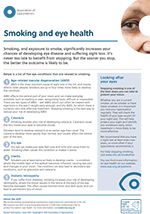Smoking and eye health
Why stopping smoking is one of the best steps you can take to protect your vision
Smoking, and exposure to smoke, significantly increases your chances of developing eye disease and suffering sight loss. It’s never too late to benefit from stopping. But the sooner you stop, the better the outcome is likely to be.
Below is a list of five eye conditions that are related to smoking.
1. Age-related macular degeneration (AMD)
AMD is the most common cause of sight loss in the UK, and mainly affects older people. Smokers are up to four times more likely to develop the condition.AMD affects the central part of your vision and can make everyday activities, such as reading or even recognising faces, difficult or impossible. There are two types of AMD – wet AMD, which can often be treated with injections in the eye if caught early enough, and dry AMD, for which there is currently very little effective treatment. Stopping smoking is the best way to reduce your risk of developing AMD.
2. Cataracts
Smoking doubles your risk of developing cataracts. Cataracts cause the lens inside your eyes to become cloudy.Smokers tend to develop cataracts at an earlier age than usual. The cataracts develop more rapidly than normal, and usually affect the central part of the lens.
3. Dry eye
Dry eye can make your eyes feel sore and itchy and cause them to water. Smoking often causes this condition or makes it worse.4. Uveitis
Smokers are at least twice as likely to develop uveitis – a condition where the middle layer of the eyeball becomes inflamed, causing eye pain and changes to your vision. The condition can also lead to secondary eye conditions, such as glaucoma and cataracts.5. Diabetic retinopathy
If you suffer from diabetes, smoking increases your risk of developing retinopathy, where the blood vessels in the retina at the back of the eye become damaged. This often causes blurred vision and dark spots and can lead to permanent loss of vision.Looking after your eyes
Stopping smoking is one of the best steps you can take to protect your vision.Whether you are a current smoker, an ex-smoker or have never smoked, it is important you visit your optometrist regularly. They will check the health of your eyes as part of your sight test. This will help protect your sight and identify any conditions early, when treatment is more likely to be more effective.
We recommend that you have a sight test at least every two years, or more often if your optometrist recommends it.
For help stopping smoking, visit www.nhs.uk/smokefree
You can find more information on eye health in the For patients pages of our website.
Download our patient leaflet on smoking and eye health.


